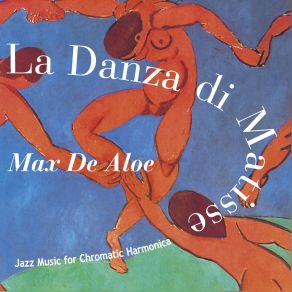La danza di Matisse (Jazz music for chromatic harmonica)
Download links and information about La danza di Matisse (Jazz music for chromatic harmonica) by Max De Aloe. This album was released in 1999 and it belongs to Jazz genres. It contains 9 tracks with total duration of 55:34 minutes.

|
|
|---|---|
| Artist: | Max De Aloe |
| Release date: | 1999 |
| Genre: | Jazz |
| Tracks: | 9 |
| Duration: | 55:34 |
| Buy it NOW at: | |
| Buy on iTunes $8.91 | |
Tracks
[Edit]| No. | Title | Length |
|---|---|---|
| 1. | La danza di Matisse | 7:12 |
| 2. | How Deep Is the Ocean? | 7:11 |
| 3. | Almost Night | 4:52 |
| 4. | Whisper Not | 7:03 |
| 5. | Yours Is My Heart Alone | 6:29 |
| 6. | Waltz for Ruth | 4:45 |
| 7. | Sail Away | 6:08 |
| 8. | Camel's Blues | 4:44 |
| 9. | Le Port de Beaulieu | 7:10 |
Details
[Edit]There is a mystery at the heart of Max de Aloe's sound in the very roots of his harmonic approach to jazz that is impenetrable. Max De Aloe is a soloist on the chromatic harmonica on the same order as his idols, Bill Evans and Brad Meldau, but he is also a cipher in that he retains in the lush romanticism of his sound, a certain cool distance that keeps it focused, sharp, and on the jazz beam. With collaborators such as bassist Massimo Moriconi and Roberto Piccolo on bass, pianists Gianfranco Calvi and Marco Detto, guitarist Luciano Zadro, and drummer Angelo Corvino, de Aloe couldn't be in better company to evoke the spirit of a painter who was deceptive in his simplicity, even confounding. De Aloe's extended harmonics ride astride the piano keyboards rather than those of the Harmonikats or even Toots Theilmans. On the title track he winds through a series of chromatic slips and turns, then accents rhythmic figures in the basslines while playing a series of large chords and single note runs that reach toward silence while engaging it with a near frivolity. On Irving Berlin's "How Deep Is the Ocean," he wrings every ounce of blues phrasing and feelings from the choruses as Calvi and Piccolo play counterpoint to his satiny harmonics. And then there's Tom Harrell's challenging "Sail Away," with its engagement with off-meter rhythms and augmented seventh counterpoint. De Aloe shoots through the middle with a lyrical elegance that holds the bridges together, cascading slowly over a melody that is only half written so as to allow a soloist to fill it in. His phrasing is full of luster and raw emotion, brining Calvi out of his responsorial mode and into one of dialogue. This is a solid album through and through, and will almost certainly make anyone with ears reconsider the role of the harmonica is straight-ahead jazz.